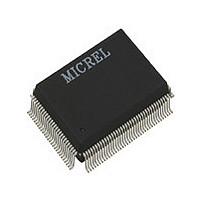KS8995E Micrel Inc, KS8995E Datasheet - Page 17

KS8995E
Manufacturer Part Number
KS8995E
Description
Manufacturer
Micrel Inc
Datasheet
1.KS8995E.pdf
(41 pages)
Specifications of KS8995E
Number Of Primary Switch Ports
5
Fiber Support
Yes
Integrated Led Drivers
Yes
Phy/transceiver Interface
MII/SNI
Power Supply Type
Analog/Digital
Package Type
PQFP
Data Rate (typ)
10/100Mbps
Vlan Support
Yes
Operating Temperature (max)
70C
Operating Temperature (min)
0C
Pin Count
128
Mounting
Surface Mount
Jtag Support
No
Operating Temperature Classification
Commercial
Lead Free Status / RoHS Status
Not Compliant
Available stocks
Company
Part Number
Manufacturer
Quantity
Price
Company:
Part Number:
KS8995E
Manufacturer:
AMD
Quantity:
5 510
Part Number:
KS8995E
Manufacturer:
KENDIN
Quantity:
20 000
KS8995E
Micrel
Functional Overview: Physical Layer Transceiver
100BaseTX Transmit
The 100BaseTX transmit function performs parallel to serial conversion, 4B/5B coding, scrambling, NRZ to NRZI conversion,
MLT3 encoding and transmission. The circuit starts with a parallel to serial conversion, which converts the RMII or SMII data
from the MAC into a 125MHz serial bit stream. The data and control stream is then converted into 4B/5B coding followed by
a scrambler. The serialized data is further converted from NRZ to NRZI format, then transmitted in MLT3 current output. The
output current is set by an external 1% 3.01k resistor for the 1:1 transformer ratio. It has a typical rise/fall time of 4 ns and
complies to the ANSI TP-PMD standard regarding amplitude balance, overshoot and timing jitters. The wave-shaped 10BaseT
output is also incorporated into the 100BaseTX transmitter.
100BaseTX Receive
The 100BaseTX receiver function performs adaptive equalization, DC restoration, MLT3 to NRZI conversion, data and clock
recovery, NRZI to NRZ conversion, de-scrambling, 4B/5B decoding and serial to parallel conversion. The receiving side starts
with the equalization filter to compensate inter-symbol interference (ISI) over the twisted pair cable. Since the amplitude loss
and phase distortion is a function of the length of the cable, the equalizer has to adjust its characteristics to optimize the
performance. In this design, the variable equalizer will make an initial estimation based on comparisons of incoming signal
strength against some known cable characteristics, then tunes itself for optimization. This is an ongoing process and can self
adjust against the environmental changes such as temperature variations.
The equalized signal then goes through a DC restoration and data conversion block. The DC restoration circuit is used to
compensate for the effect of base line wander and improve the dynamic range. The differential data conversion circuit converts
the MLT3 format back to NRZI. The slicing threshold is also adaptive.
The clock recovery circuit extracts the 125MHz clock from the edges of the NRZI signal. This recovered clock is then used to
convert the NRZI signal into the NRZ format. The signal is then sent through the de-scrambler followed by the 4B/5B decoder.
Finally, the NRZ serial data is converted to the RMII or SMII formats and provided as the input data to the MAC.
PLL Clock Synthesizer
The KS8995E generates 125MHz, 42MHz, 25MHz and 10MHz clocks for system timing. Internal clocks are generated from
an external 25MHz crystal.
Scrambler/De-Scrambler (100BaseTX only)
The purpose of the scrambler is to spread the power spectrum of the signal in order to reduce EMI and baseline wander. The
data is scrambled by the use of an 11-bit wide linear feedback shift register (LFSR). This can generate a 2047-bit non-repetitive
sequence. The receiver will then de-scramble the incoming data stream with the same sequence at the transmitter.
100BaseFX Operation
100BaseFX operation is very similar to 100BaseTX operation with the differences being that the scrambler / de-scrambler and
MLT3 encoder/decoder are bypassed on transmission and reception. In this mode the auto-negotiation feature is bypassed
since there is no standard that supports fiber auto-negotiation.
100BaseFX Signal Detection
The physical port runs in 100BaseFX mode if FXSDx >0.6V. This signal is referenced to VREFx which is set at 1/2 Vdd but
can be overridden by an external level. VREFx can be connected to the “minus” signal of a differential pair coming from the
fiber module (“plus connects to FXSDx) used to convey signal detect. When FXSDx is below 0.6V then 100BaseFX mode is
disabled.
100BaseFX Far End Fault
Far end fault occurs when the signal detection is logically false from the receive fiber module. When this occurs, the
transmission side signals the other end of the link by sending 84 1’s followed by a zero in the idle period between frames.
10BaseT Transmit
The output 10BaseT driver is incorporated into the 100BaseT driver to allow transmission with the same magnetics. They are
internally wave-shaped and pre-emphasized into outputs with a typical 2.3V amplitude. The harmonic contents are at least
27dB below the fundamental when driven by an all-ones Manchester-encoded signal.
10BaseT Receive
On the receive side, input buffer and level detecting squelch circuits are employed. A differential input receiver circuit and a
PLL perform the decoding function. The Manchester-encoded data stream is separated into clock signal and NRZ data. A
squelch circuit rejects signals with levels less than 400mV or with short pulse widths in order to prevent noises at the RXP or
RXM input from falsely triggering the decoder. When the input exceeds the squelch limit, the PLL locks onto the incoming signal
and the KS8995E decodes a data frame. The receiver clock is maintained active during idle periods in between data reception.
August 2003
17
KS8995E












